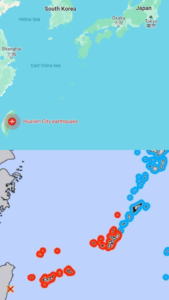Today, Taiwan woke up to a nightmare as the ground beneath shook violently, marking the strongest earthquake to hit the island in the past quarter-century. The tremors, measuring a staggering magnitude of 7.7, jolted the nation at 8 am local time on Wednesday, April 3rd, leaving a trail of destruction and despair in its wake.
The quake, along with a series of powerful aftershocks, rattled the island, sending shockwaves of panic and fear through communities. Officials swiftly confirmed the grim toll: four lives were lost and over 60 individuals were injured. The toll of human suffering is immeasurable, leaving families shattered and communities in mourning.

Epicenter: Hualien City’s Heartbreak
The epicenter of the earthquake, located 18 kilometers south of Hualien City, struck at a depth of 34.8 kilometers, amplifying its impact. The aftermath painted a grim picture with 26 buildings reduced to rubble, more than half of them in Hualien. Tragically, approximately 20 people remain trapped beneath the debris, their fate uncertain as rescue efforts race against time.
Echoes of Tragedy: Remembering 1999’s disaster of Taiwan*
For a nation still haunted by the memory of past disasters, this earthquake resurrected chilling echoes of the September 1999 quake, which claimed the lives of 2,400 people. Dr. Chein-Fu Wu, Director of Taipei’s Seismology Center, solemnly acknowledged the magnitude of the devastation, drawing parallels to the catastrophic event of over two decades ago.
Beyond Borders: Ripple Effects
The repercussions of the earthquake rippled beyond Taiwan’s borders, with over 87,000 households plunged into darkness amidst power outages. However, amidst the chaos, a sigh of relief resonated as Taiwan’s two nuclear power stations remained unscathed by the quake, averting a potential nuclear disaster.
Regional Impact: The Quake’s Reach
The tremors reverberated across neighboring regions, with the Chinese province of Fujian feeling its ominous tremble. In Japan, the weather agency reported the arrival of several small tsunami waves in Okinawa, triggering brief moments of panic. Thankfully, Japan later reassured its citizens by downgrading the tsunami warning. Similarly, the Philippines, on high alert, eventually lifted its tsunami warning, offering a momentary respite amidst the chaos.

Rebuilding Amidst Resilience
As Taiwan grapples with the aftermath of this catastrophic event, the resilience and solidarity of its people shine through the darkest of times. Amidst the rubble, communities unite, extending a helping hand to those in need, embodying the indomitable spirit that defines Taiwan. Though shaken, the island nation stands strong, ready to rebuild and reclaim its future from the clutches of tragedy.
As the dust settles and the full extent of the devastation becomes apparent, Taiwan launches into action with an urgent and coordinated search and rescue operation. Teams of first responders, firefighters, and volunteers descend upon the affected areas, risking their lives to comb through the rubble in search of survivors. With each passing moment critical, every effort is focused on reaching those trapped beneath the debris and bringing them to safety.

In the wake of the disaster, both national and international communities rally together to support Taiwan in its hour of need. Governments around the world offer condolences and pledges of assistance, while relief organizations mobilize resources and personnel to provide aid to those affected. Taiwan’s government wastes no time in declaring emergency relief funds and allocating resources to support the displaced and injured, ensuring that no one is left behind in their time of suffering. Amidst the chaos, medical teams work tirelessly to provide urgent care to the injured. Make-shift triage centers spring up to treat those with minor injuries, while hospitals brace themselves for an influx of more severe cases.
Ground Operations: Assessing Damage and Rebuilding
As the initial shock begins to fade, attention turns to the monumental task of assessing the extent of the damage and initiating the long process of rebuilding. Engineers and structural experts survey the affected areas, evaluating the integrity of buildings and infrastructure to determine safety hazards and prioritize reconstruction efforts. Government agencies collaborate with local authorities and community leaders to develop comprehensive plans for rebuilding, ensuring that the recovery process is swift, efficient, and equitable for all those affected.
During tragedy, Taiwan stands united, drawing strength from its people’s resilience and determination to overcome adversity. While the road ahead may be long and fraught with challenges, the spirit of solidarity and compassion that binds the nation together will serve as a beacon of hope, guiding Taiwan through the darkest of times toward a brighter future.


